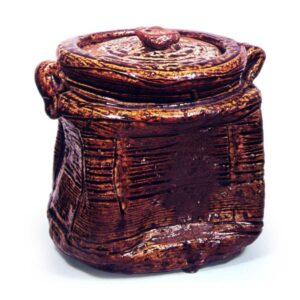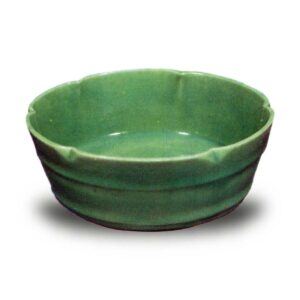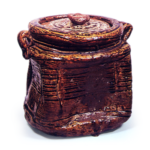

A type of tea utensil. A water reservoir with a lid used at tea ceremonies. It is used to pour water into a kettle with a ladle or to rinse a tea bowl or a tea whisk. It can be made of metal, wood, or ceramics, including glass, but ceramics are most appreciated. In the ancient days of the Shoin-daiko style from the Higashiyama period (710-794) onward, most of them were made of copper or a metal called nanban-dou (copper), and there were kae-bucket, chabucket, han-bucket, ehgo, kenka, rice bowl, steamer, tea tray and suribon, etc., while wooden ones were tsuribin and tebucket. In the early days, however, many of them were made to look like folk utensils, such as oke (buckets), etc. In the Tensho period (1573-92) during the reign of Rikyu, Seto water jars began to flourish, and in the period of Furuta Oribe, strong orders were placed to Seto, Mino, Iga, Bizen, Karatsu, and other regions for wares to suit their taste. Later, with the rise of pottery kilns in various countries, water jars from Chikuzen, Buzen, Higo, Satsuma, Omuro ware, etc. appeared, and Sotan’s favorite Raku ware also appeared.
According to the water jar section of the Chado Sen-tei (Tea Ceremony Sen-tei) of 1816, there were Chinese wares such as Hodoke, Tenjiku, Saigokin, and Moorukin, celadon wares such as Unkaku, Kinuta, Tenryuji, and Shichikan, and Namban wares such as Nawanoren (but not Yokonoren, a horizontal bamboo blind) and Nankan wares such as Nawa-noren (but not a horizontal bamboo blind). In addition, there are twelve kilns listed in the section on Japanese ceramics and earthenware, and eight types of forms, including Sotan’s favorite, are recorded in the section on Raku ware. The “Wamono Clay Pottery” section lists twelve kilns. In addition, Matsudaira Fumai’s storehouse account book lists over 100 ryo as Nawa-noren, Shigaraki san-yu, Bizen ippiki, kiri-nanban-mimitsuke, kosunkoroku-head, nanban-bowl-shaped, kobizen arrowhead, Shigaraki evening cherry, the same ippiki, gosu-rhomba, astringent paper glaze, Ibe ippodo, hanging potato head, Iga ippodo, Fujishiro ippiki, Shino nade-angle, and Seto-keguchi, etc. The water jar is inseparably linked to the tea ceremony and is treated as a tanamono, and so-called katamono water jars include Shozui mikan (mandarin orange), taro head with underglaze blue, Manryaku masu, celadon drum body, grapevine with underglaze blue, Gosu ryoma, celadon iron bowl, tub side with underglaze blue, Gosu jubikaku, red hair tobacco, bamboo painting with underglaze blue, Sakuragawa with underglaze blue, and so forth. Te-mizutsuji is sometimes referred to as mizusashi, which has a handle and spout, and may be substituted for mizusashi only in cases where the large mouth, one side of the mouth, and tea kettle are simplified.








